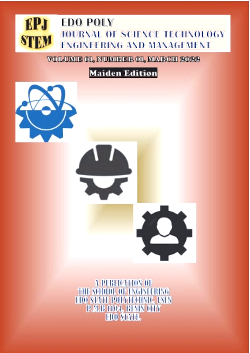Examination of Workers' Preferences for Reinforcement Packages
Keywords:
Extrinsic factors, Intrinsic factors, Motivation, Reward, Reinforcement packagesAbstract
Reinforcement packages are a type of incentive strategy used by organisations to inspire their employees or employees' families. Compensation is a commitment that the organisation owes to its personnel as a means of compensating them for their contribution to the achievement of organisational goals. Employee motivation in the workplace is still one of the most delicate things to discuss since it determines the level of effort that employees will put forth in the business in order to commit to high levels of performance. Primary data were gathered from mini survey questionnaires provided to employees of Edo State Polytechnic, Usen, in order to identify several sorts of reinforcement packages based on the preferences of employees. According to the findings of this study, employees choose extrinsic benefits (such as cash or monetary compensation) over any other sort of compensation.
References
Armstrong, M. (2010). A Handbook of Human Resource Management Practice. 10th ed. Kogan Page: London.
Baron, R.A. (1983). Behaviour in organizations. New York: Allyn & Bacon, Inc.
Bhattacharyya, D.K. (2009). Human Resource Research Methods. 2nd ed. New Delhi: Excel Books.
Bratton, J., & Gold, J. (2007). Human Resource Management: Theory and Practice (4th ed.). London: Palgrave Macmillan.
Chien, M.S., Lawler, J.S and Jin-Feng, U (2010). “Performance-Based Pay, Procedural Justice and Job Performance for R&D Professionals:
Evidence from the Taiwanese High-Tech Sector,” International Journal of Human Re-source Management, Vol. 21, No. 12, 2010, pp. 2234- 2248.
Cristofori, I., Salvi, C., Beeman, M., & Grafman, J. (2018). The effects of expected reward on creative problem solving. Cognitive, Affective, &
Behavioural Neuroscience, 18(5), 925–931. https://doi.org/10.3758/s13415-018-0613-5
Dad, H., Ali, R., Janjua, M.Z.Q., Shahzad, S., & Khan, M.S. (2010). Comparison of the frequency and effectiveness of positive and negative
reinforcement practices in schools. Contemporary Issues in Education Research, 3(1), 127–136. https://doi. org/10.19030/cier.v3i1.169
Franco-Santos, M., & Gomez-Mejia, L. (2015). Reward systems. Human Resource Management, 1-6. https://doi.org10.1002/9781118785317.weom050102
Gbande, R. (2016). Effects of reward system on productivity in the local government system in Benue state. Journal of Economics and Sustainable Development, 7(22), 202–210.
Gohari, P., Ahmadloo, A., Boroujeni, A.M and Hosseinipour, S.J (2013). “The Relationship between Rewards and Employee Performance,”
Interdisciplinary Journal of Contemporary Research in Business, Vol. 5, No. 3, pp. 543-570.
Hafiza, S.N., Shah, S.S., Jamsheed, H., & Zaman, K. (2011). Relationship between rewards And employee’s motivation in the non-profit
organizations of Pakistan. Business Intelligence Journal, 4(2), 327-329.
Howard, J.L (2008). “The Use of Non-Monetary Motivators in Small Business,” The Entrepreneurial Executive, Vol. 13, 2008, pp. 17-29.
Kreisman, B.J. (2002). Insights into Employee Motivation, Commitment and Retention. White Paper. Insights Denver.
Kuranchie-Mensah, E.B and Amponsah-Tawiah, K (2016): Employee motivation and work performance: A comparative study of mining companies in Ghana, Journal of Industrial Engineering and Management (JIEM), ISSN 2013-0953, OmniaScience, Barcelona, Vol. 9, ISSN. 2, pp. 255-309, http://dx.doi.org/10.3926/jiem.1530
Linz, S.J and Semykina, A (2012). “What Makes Workers Happy? Anticipated Rewards and Job Satisfaction,” In-dustrial Relations, Vol. 51, No. 4, pp. 811-844. http://dx.doi.org/10.1111/j.1468-232X.2012.00702.x
Micah, J.D and Imoudu, M (2013). "The Role of Welfare Package in Employees Motivation: An Analysis" Volume 2013, Article ID sjsa-129, 9 Pages, 2013, doi: 10.7237/sjsa/129
Mullins, L.J. (2010). Management and Organisational Behaviour. 10th ed. Harlow, FT Prentice Hall.
Nwokocha, I. (2016). Managing reward strategy to enhance employee performance, retention and productivity in organizations: A general
overview. International Journal of Development and Management Review, 11(1), 20–38.
Saleem, S. (2011). The impact of financial incentives on employees’ commitment. European Journal of Business and Management, 3(4), 258–
Shiraz,N., Rashid, M and Riaz, N (2011). “The Impact of Re-ward and Recognition Programs on Employee’s Motiva-tion and Satisfaction,”
Interdisciplinary Journal of Con-temporary Research in Business, Vol. 3, No. 3, 2011, pp. 1428-1434.
Somoye, K.G., & Eyupoglu, S.Z. (2020). The functionality of reward in influencing the reinforcement of performance evaluation criteria and
organisational commitment among employees. South African Journal of Business Management, 51(1), a1848. https://doi.org/10.4102/
sajbm.v51i1.1848
Sonawane, P (2008). “Non-monetary Rewards: Employee Choices & Organizational Practices,” Indian Journal of Industrial Relations, Vol. 44,
No. 2, 2008, pp. 256-271.
Wei, L.T and Yazdanifard, R (2014). The impact of Positive Reinforcement on Employees’ Performance in Organizations. American Journal of
Industrial and Business Management, 2014, 4, 9-12 Published Online January.(http://www.scirp.org/journal/ajibm) http://dx.doi.org/10.4236/ajibm.2014.41002



